2022.09.15 Trademark
What are the conditions to obtain a trademark registration of a mark consisting of a base pattern?
1. Introduction
A relatively large number of apparel companies often use designs consisting of so-called base patterns of fabric designs as their icons that symbolize their brands. B to C companies other than apparel companies also exhibit many examples of instilling their brands in their customers by employing base pattern designs, which represent their brand image, to their products and to the wrapping papers for their products.
Such efforts can be seen in business activities based on animated cartoons.
Shueisha, the publisher of one of the mega-hit cartoons in Japan, “Kimetsu no Yaiba” (Demon Slayer) (https://www.viz.com/search?search=Demon+Slayer%3A+Kimetsu+no+Yaiba), filed six Japanese trademark applications in 2020 of six designs of the fabrics of kimonos worn by the characters with respect to goods related to telecommunication machines and apparatus (class 9); goods related to personal ornaments and clocks and watches (class 14); goods related to stationery (class 16); goods related to bags and the like (class 18); goods related to clothing (class 25); and goods related to toys (class 28). Three of the six applications ((i) to (iii) shown below) were granted trademark registrations in June of 2021.
Shueisha, the publisher of one of the mega-hit cartoons in Japan, “Kimetsu no Yaiba” (Demon Slayer) (https://www.viz.com/search?search=Demon+Slayer%3A+Kimetsu+no+Yaiba), filed six Japanese trademark applications in 2020 of six designs of the fabrics of kimonos worn by the characters with respect to goods related to telecommunication machines and apparatus (class 9); goods related to personal ornaments and clocks and watches (class 14); goods related to stationery (class 16); goods related to bags and the like (class 18); goods related to clothing (class 25); and goods related to toys (class 28). Three of the six applications ((i) to (iii) shown below) were granted trademark registrations in June of 2021.
However, the JPO rejected the other three applications ((iv) to (vi) shown below) stating a reason that they are marks consisting of base patterns that have no distinctiveness. The applicant tried to refute such decision of the JPO by submitting written arguments; however, a decision of rejection was issued on September 24, 2021, and the decision was then made final.
Now, what is the difference between the allowed trademark applications and the rejected trademark applications?
In this article, while introducing answers to this question (current standards of judgment in Japan), we would like to think about what can be done to obtain a trademark registration of a mark consisting of a base pattern in Japan under the current practice.
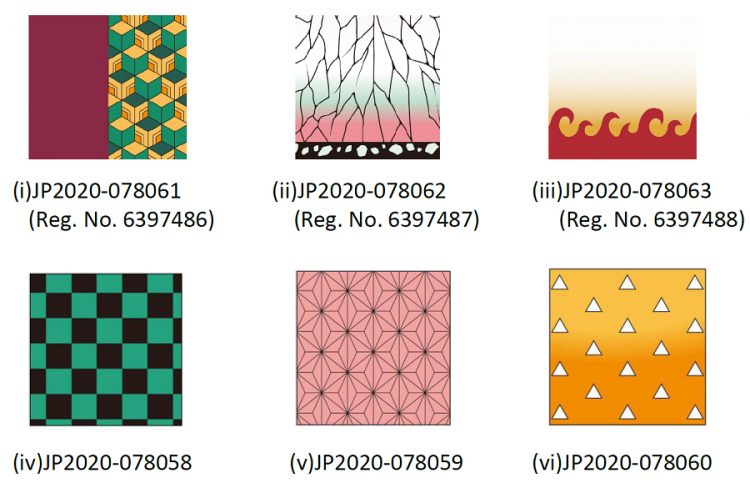
2. Examination Practice concerning marks related to the “Base Pattern”
Previously, in the Examination Guidelines for Trademark in Japan, it was only stipulated that a trademark that consists solely of a base pattern (continuously repeated figures in pattern) is a trademark by which consumers are not able to recognize the goods or services as those pertaining to a business of a particular person (Trademark Act, Article 3(1)(vi)), (in other words, cannot be granted a registration).
However, the Examination Guideline for Trademark was revised on April 1, 2016 which clearly states that even a trademark consisting of a base pattern may be granted a registration if it can be determined not to fall under the provision of Trademark Act, Article 3(1)(vi) as a result of judgment in accordance with the revised Examination Guideline for Trademark provided that other legal requirements are met.
◎ Examination Guidelines for Trademark(Before Revision (until March 31, 2016))1. A trademark that consists solely of a base pattern (for example, continuously repeated figures in pattern) falls under the provision of this item.(After Revision (as of April 1, 2016))7. Trademark consisting solely of a base patternWhere a trademark is recognized as a mere base pattern, since it consists of continuously repeated figures in pattern, it is judged to fall under this item.However, even if a trademark is recognized as a base pattern, whether it falls under the provision of this item is determined based on if there is any characteristic shape in its composition.
In both cases of before and after the aforementioned revision, the Examination Guideline for Trademark also stipulates that, even if the trademark is acknowledged as consisting solely of a base pattern, the trademark does not fall under the provision of Trademark Act, Article 3(1)(vi) provided that the trademark acquired distinctiveness through its use (meaning that the trademark registration may be granted).
Based on the revised Examination Guideline for Trademark introduced above, described below is a diagram (flow chart) of how it is determined whether the requirements for a trademark registration with respect to the distinctiveness are met regarding a trademark application containing a mark of a base pattern.
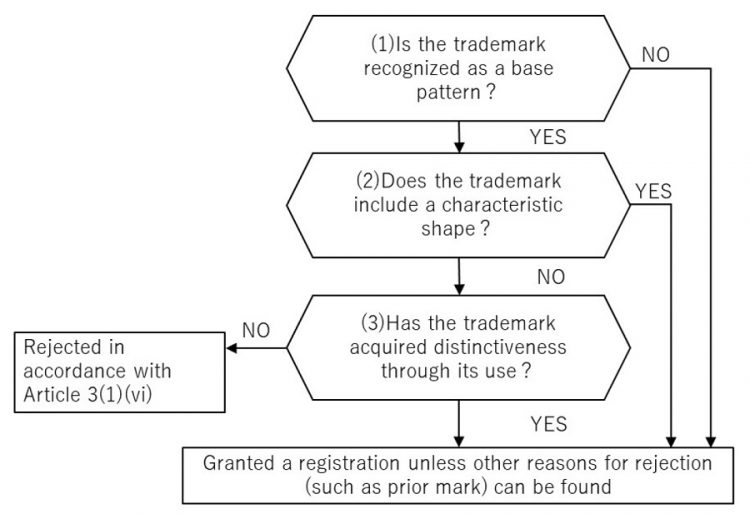
Flow chart:flow to determine presence of distinctiveness of the base pattern
Hereinafter, specific examination results and appeal decision precedents that can be used as examples of determination at each of the above steps (1) to (3) will be introduced.
●Step (1) Example cases with respect to “If the trademark is recognized as a base pattern”:
The following are examples where trademarks were recognized as mere base patterns (in other words, determined as YES at step (1) and then determined as NO at steps (2) and (3)).
These two examples were both rejected because it was determined that they were both base patterns consisting of continuously repeated figures in pattern and have no characteristic shape that may be able to act as distinctive function beyond the figures of the base patterns.
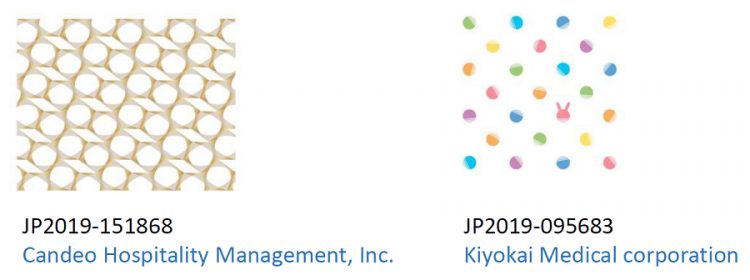
Meanwhile, the trademark below was determined in an appeal decision as not being a base pattern and granted a registration (in other words, as a result of being determined as NO at step (1) and determined that other reasons for rejection cannot be found).
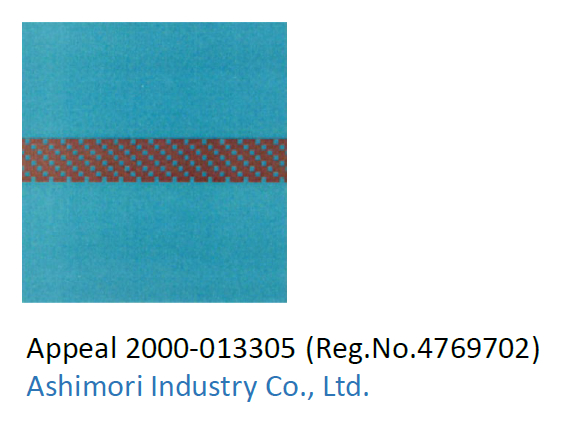
Determination in Appeal Decision:
“It is appropriate to acknowledge that this figure is a kind of a geometric pattern. Therefore, it cannot be determined that this trademark merely represents a base pattern as said in the original decision.”
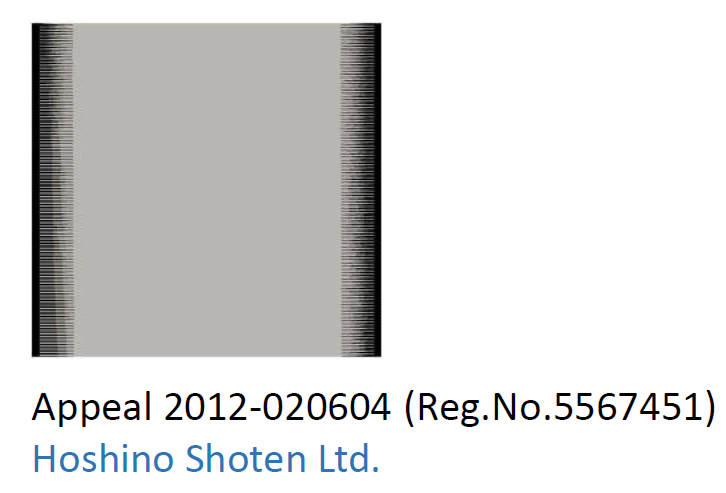
Determination in Appeal Decision:
“It is appropriate to see this trademark… as a mark representing a geometric pattern having a kind of characteristic shape. Therefore, it cannot be determined that this trademark consists of a repeated base pattern as said in the original decision.”
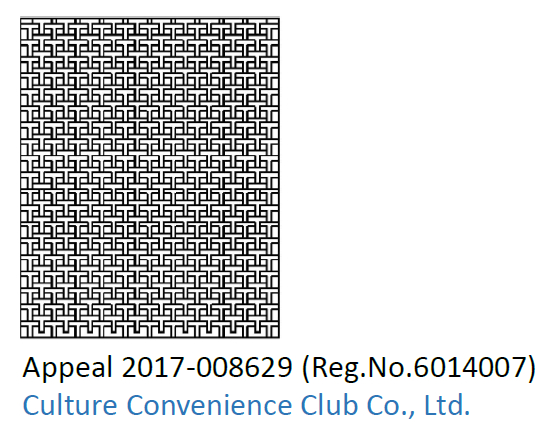
Determination in Appeal Decision:
“In relation to the designated goods and services, it is appropriate to acknowledge and construe the said figure as a characteristic figure that represents a rectangular shape by arranging T-shaped motifs rather than a mark representing a mere base pattern or repeated decorative patterns used on a surface or a package of goods to be used for the provision of goods and services and goods handled in retail services.”
●Step (2) Example cases with respect to “Does the trademark include a “characteristic shape?”:
In the appeal decision examples set forth below, although the subject trademarks were determined as being base patterns, the overall arrangement of the trademarks are determined as including characteristic shapes and granted registrations (in other words, they were determined as YES in step (1) and yet determined as YES in the subsequent step (2)).
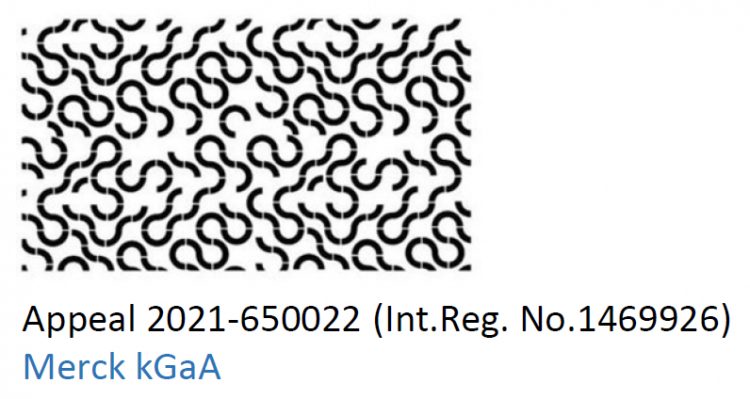
Determination in Appeal Decision:
“As [a trademark by which consumers are not able to recognize the goods or services as those pertaining to a business of a particular person] cannot be granted a registration according to Trademark Act, Article 3(1)(vi), it is usually understood that a trademark that solely consists of a base pattern (for example, continuously repeated figures in pattern) fall under this provision, it is also judged that “there may be a case where even a base pattern of goods possesses discriminating function from other companies’ goods if the base pattern exhibits a characteristic shape or uniqueness” (Decision of August 10, 2000: Tokyo High Court 1999 (Gyo-Ke) No. 80).
In light of this, since the subject trademark… has a characteristic shape in its overall arrangement, it cannot be said that it is a simply familiar repeated pattern.”
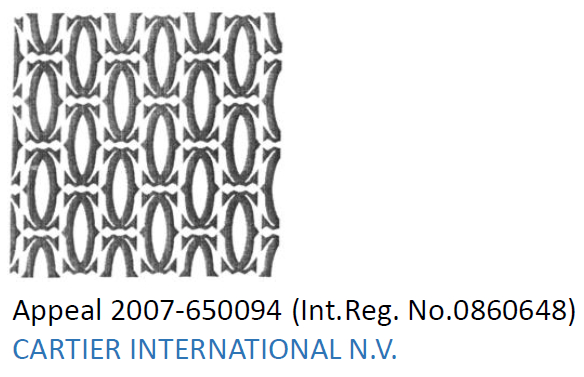
Determination in Appeal Decision:
Likewise the above case, it is determined that “since it cannot be said that the subject trademark is a simply familiar repeated pattern and thus it is appropriate to say that its arrangement is characteristic” by citing [Decision of August 10, 2000; Tokyo High Court 1999 (Gyo-Ke) No. 80].
●Step (3) Example cases with respect to “Has the trademark acquired distinctiveness through its use?:
Those trademarks set forth below were determined to acquire distinctiveness through their use, although they consist solely of base patterns, and granted registrations (in other words, they were determined as YES in step (1) and NO in step (2) but YES in step (3)).
It appears that if the trademark is well acknowledged through consumers so much so that phrases that indicate the pattern, such as “ISETAN check” and “pake-gara”, are known as shown in the examples below, it is effective as a ground to prove that the trademark has acquired distinctiveness through its use.
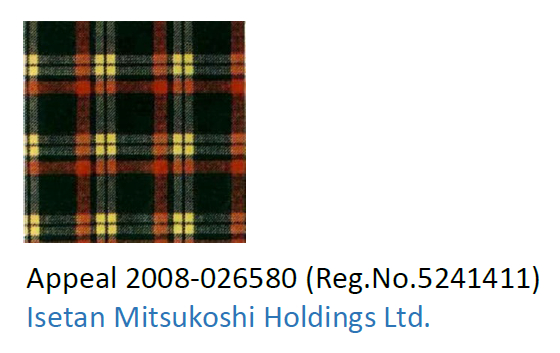
Determination in Appeal Decision:
“It is acknowledged that the pattern like the mode exhibited in the subject trademark is generally used as a design of goods such as “scarf” and “skirt”. Therefore, the subject trademark can usually be acknowledged as consisting solely of a base pattern (continuously repeated figures in pattern). However, … the fact is acknowledged that the appellant (applicant) has produced a shopping bag (hereinafter, “paper bag”) having the subject trademark, and since then, for a long time, has provided customers who purchased their goods with the paper bags. And, as a result, the subject trademark has been called as “ISETAN check” that includes a part of the name of the appellant. This fact is obvious as the name “ISETAN check” is used in a newspaper article shown in the appendix 2.”
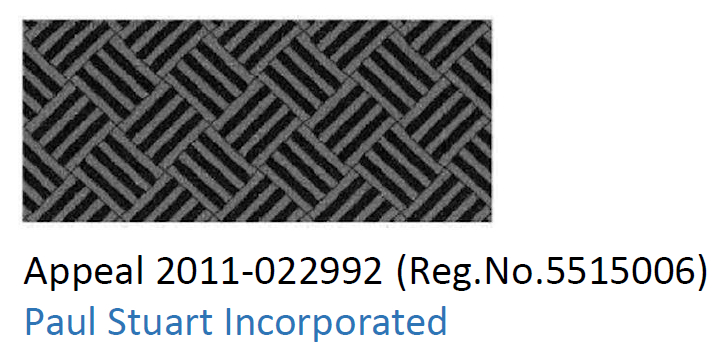
Determination in Appeal Decision:
“Judging from the mode exhibited on the subject trademark, a characteristic shape or a uniqueness cannot be found in the subject trademark per se”. Therefore, the subject trademark can usually be acknowledged as consisting solely of a base pattern (continuously repeated figures in pattern). However, … the appellant has been producing and selling, for a long time, many goods such as “clothing, bags, shoes, blankets, and towels” with the subject trademark called “pake-gara”. And, as a result, it is acknowledged that the subject trademark has been known as “pake-gara” of “Paul Stuart”, the brand of the appellant, and has gained popularity.”
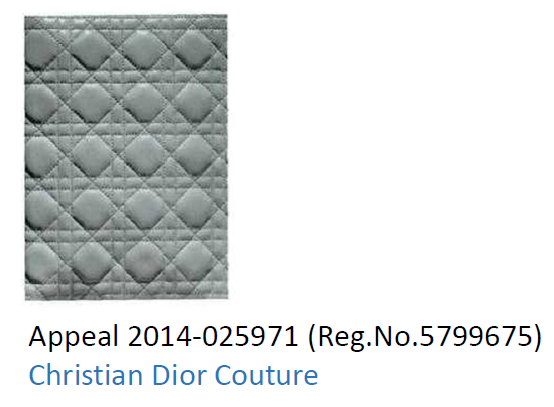
Determination in Appeal Decision:
Though it was acknowledged that “it can be said that the subject trademark consists solely of a base pattern”, it was determined that “it is acknowledged as a fact that the appellant has been continuously using the subject trademark on its designated goods since 1995; and, it is also acknowledged that the subject trademark has been widely known among the customers as “the cannage pattern representing the goods of the appellant” with respect to its designated goods.
Now we have introduced examination practices on the trademarks concerning the “base pattern”. We would like to briefly introduce again how the aforementioned six ((i) to (vi)) trademark applications with respect to “Kimetsu no Yaiba” (Demon Slayer) were differently judged.
In response to receiving notices of reasons for rejection for the three trademark applications ((iv) to (vi)), the applicant made a rebuttal in written arguments. More specifically, the applicant argued that these trademarks should not be acknowledged as base patterns as they did not consist of continuously repeated patterns since the edges of the trademarks were surrounded by black frames (in other words, it should be determined as NO in step (1)) and that the trademarks contained characteristic shapes (in other words, it should be determined as YES in step (2)).
However, the JPO denied the applicant’s argument pertaining to step (1) mentioning that the black frames surrounding the edges of the subject trademarks were difficult to acknowledge at a glance. In addition, the JPO also denied the applicant’s argument pertaining to step (2) raising reasons such as that the patterns exhibited as the subject trademarks were popular as Japanese traditional patterns. As a result, the JPO issued decisions of rejection for the three trademark applications (iv) to (vi).
Meanwhile, with respect to the other three trademark applications (i) to (iii), the JPO issued allowances without issuing any notices of rejections. It appears the JPO determined that these trademarks cannot be acknowledged as consisting solely of base patterns and that the trademarks may be recognized to include characteristic shapes.
3. Conclusion
As it has been mentioned above, in Japan, even if a subject trademark is continuously repeated figures in pattern, it may be granted a registration depending on the rebuttal when the subject trademark is not recognized as “a mere base pattern”. In addition, even if the subject trademark is acknowledged as “a mere base pattern”, it may be granted a registration in a case where the applicant can appropriately argue that the trademark “include a characteristic shape”. Whether or not it is acknowledged as “including a characteristic shape” may also rely on if the applicant can appropriately explain the uniqueness of the shape based on relationships between the subject trademark and the designated goods or services and based on relationships between the subject trademark and current conditions of business using the subject trademark.
If your company is planning to obtain a “base pattern” trademark registration in Japan, please provide us with the trademark along with related information indicating current conditions of business using the trademark. We are happy to create a strategy to obtain a trademark registration based on court precedents and past appeal decisions that may relate to your case and provide you with a custom made proposal for your company.
Edited by Rieko Yoshimoto and Keisaku Ishihara
